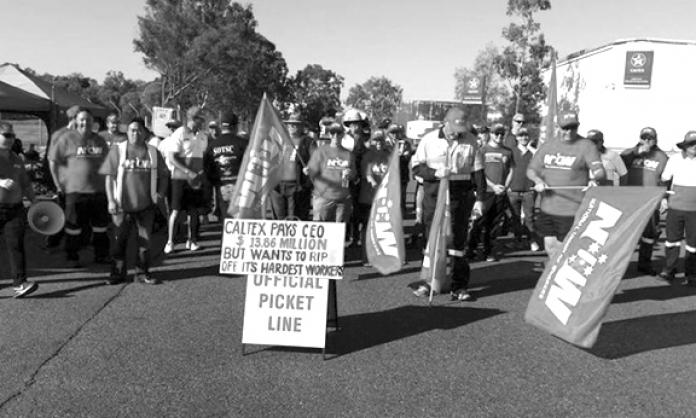Workers at Caltex’s lubrication manufacturing plant and distribution centre in Brisbane have voted to return to work after 10 days of striking to defend their pay. Their action was sparked by management’s plans, as part of a new enterprise agreement, to reduce the work week from 42 to 38 hours and cut redundancy entitlements.
The change to their usual work week would have left workers with between 15 and 20 percent less take-home pay because the last two hours of their week were paid at 160 percent of ordinary pay.
The 50-strong workforce has much to be proud about. The strike was the first at the site since 1987, when it was run by Ampol, and for many workers it was their first experience of industrial action. Workers who spoke to Red Flag explained that on the picket line the feeling of unity was strong and that this was crucial to maintaining enthusiasm for the strike. Some had prepared to be out the gate for a month.
Their strike, which halted production at the plant, put Caltex under tremendous pressure. The Brisbane plant is Caltex’s sole Australian production point for lubricants. Within days of workers picketing the plant and the neighbouring Caltex refinery, the company had sought an injunction against the National Union of Workers. Documents filed by the company in the Supreme Court claimed losses of $1 million in the first week of the strike alone.
Ten days in, workers remained steadfast, and the company was clearly feeling the pinch when the union negotiator recommended that the workers accept an offer. The company’s revised proposal was for the work week to be reduced to 38 hours, with the last three hours being paid at 180 percent of the ordinary rate. Any time worked beyond that would be paid at 200 percent. Redundancy entitlements would be reduced for new starters but preserved for others. The pay offer was 6 percent over the life of the three-year agreement.
The new terms reduce the take-home pay of workers working a standard week by just over $100. This is much less then the company’s original proposal, which would have cut around $250 from many workers’ pay packets.
The vote to accept management’s offer was subdued. Twenty percent voted against, with one person arguing to the group that they should stick it out to get at least 40 hours a week. Though some strikers clearly thought they could get more, the Caltex workers don’t return to work feeling defeated. They fought hard and managed to push back important parts of the company’s offensive.










